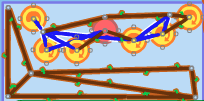I was hoping to write more often in August, but a hand injury has put a crimp in my plans. Typing is slower than normal and a little painful, and so I have been weary of spending too much time on a keyboard. But it is now the middle of the month and my #MTBoSBlaugust posts have been few and far between, so here goes…
For today’s post I am going to share some of my favourite Twitter bookmarks from the last two weeks – the inspiring ideas that I have seen from the creative teachers in the Twitterverse. I won’t get through them all in one post and so I will revisit this another day. There doesn’t seem to be enough time to properly investigate and figure out how to use all of these ideas, but one can dream…..
There is so much to explore on the Transum website. I like the Starter of the Day, Maths on Display, and Fun Maths sections. However you may want to check out Transum’s Twitter post about their Back to School page:
Keep this link somewhere safe ready for your first day with a new class: https://t.co/3iM7mQA80a It contains links to my favourite Back To School Maths activities and related resources (E.g. equipment list) #BacktoSchool #mathschat #mathchat #mathed #Iteachmath #teaching pic.twitter.com/dStIkZZly8
— Transum (@Transum) August 16, 2019
Jake Miller shares so many tech tips, especially related to GoogleEdu. This was my favourite so far this month:
So, if you're in a bulleted list & hit Shift+Enter you'll move down to the next line without a bullet & then, if you hit enter, you'll move down to the next line WITH a bullet. Same with numbered lists (without skipping a number). I'm oddly amazed & perplexed by this.
— Jake Miller (@JakeMillerTech) August 2, 2019
NASA Stem Engagement shares how to make a solar oven. I wanted to do this with my grade 7 students last year but ran out of time.
Be a science superhero & harness the power of the Sun to create a tasty treat this weekend! ☀️ Find out how you can build a solar oven powerful enough to make s'mores. Yum! https://t.co/8WlYxSDxvN pic.twitter.com/zbwy7l41Ch
— NASA STEM Engagement (@NASASTEM) August 2, 2019
Gary Rubin shared the new EquatIO Activity Database. I can’t wait to find time to go through the activities!
Summer is a great time to explore new #edtech in preparation for #BackToSchool. Start exploring #EquatIO by taking a look at our new EquatIO Activity Database. It is a collection of fun #math and #STEM activities designed by teachers, for teachers! https://t.co/jcVsp38rAX #mtbos pic.twitter.com/SKXWjh6ejB
— Gary Rubin (@TH_Gary) August 5, 2019
Paul Andersen (Bozeman Science) shared the Teacher’s Guide to Scientific Inquiry. I really want to explore this site (oh, to find the time).
The first sacrificial draft of my Teacher's Guide to Scientific Inquiry is complete. Feedback as always is welcome. https://t.co/Re4MVYPADV pic.twitter.com/es7m89S54N
— Paul Andersen (@paulandersen) August 6, 2019
Everything Sarah Carter. Last week she shared the Mathonyms site, which I proceeded to then explore how different words would look in their math font.
And I think that my new favourite follow is Interesting Engineering. So much fun.
These cool hand-crafted wooden boxes are protected with complex puzzles.
Via: @kagensound pic.twitter.com/K2dBZ2H3Im
— Interesting Engineering (@IntEngineering) August 13, 2019
This doesn’t even begin to cover all of the amazing things I have read on Twitter over the last two weeks.
More to come.







